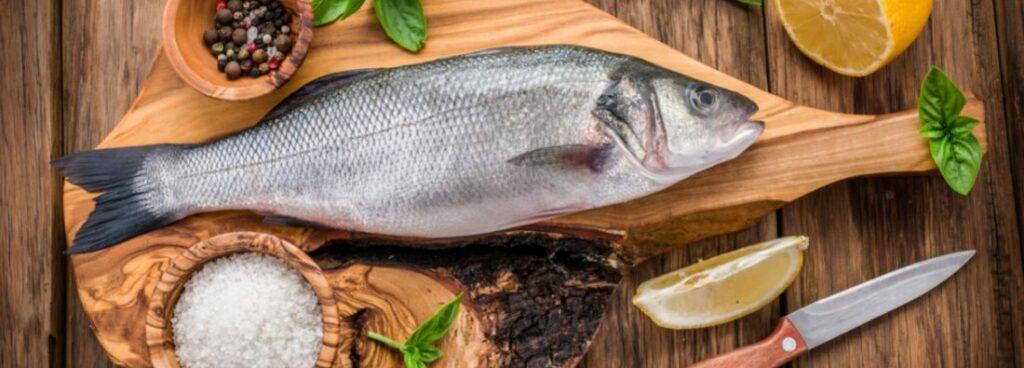Stories Worth Reeling In...
Last Updated on September 23, 2024
It’s easy to get them mixed up when it comes to fish. But there’s a big difference between Seabass and Seabream.
This article will explore the differences between these two fish, so you can make an informed choice the next time you’re at the seafood counter or out on a shore fishing trip.
Table of Contents
No, Sea Bream and Sea Bass are not the same. They are two different species of fish that belong to other families. The Sea Bream belongs to the Sparidae family, while the Sea Bass, belongs to the Moronidae family. They have different physical characteristics, habitats, and diets, which distinguish them from each other.
One of the key differences between Seabass and Seabream is their physical appearance. Seabass typically has a more sleek and streamlined body than Seabream, which has a rounder and plumper body. In terms of color, Seabass has a more uniform dark color, while Seabream can range from silver to gold in color.

Seabass and Seabream live in saltwater environments and are commonly found in the Mediterranean and Eastern Atlantic oceans. Seabass is usually fished along rocky coastlines, while Seabream is frequently caught in sandy or muddy bottoms.
The scientific name for Seabass is Dicentrarchus labrax, while Seabream is known as Sparus aurata. Knowing these Latin names can help identify the fish species accurately and research more information about them.
Seabass and Seabream have different dietary preferences.
Seabass primarily feeds on small fish, squid, and crustaceans, while Seabream mostly eats algae, small mollusks, and crustaceans.
Knowing what these fish species feed on can help determine the best bait to use when fishing for them.
The best time to fish for Seabass and Seabream will vary depending on the location and the species. Some areas have peak fishing seasons, while others may have year-round fishing opportunities.
Researching the local fishing regulations and talking to experienced fishermen can give you a better idea of when to plan your fishing trip.

If you are interested in fishing for Seabass and Seabream, there are many great fishing spots across the Mediterranean and Eastern Atlantic oceans.
Some popular locations include the coasts of Portugal, Spain, Italy, and Greece.
When fishing for these species, it is important to follow local fishing regulations and use sustainable fishing practices, such as using circle hooks to minimize damage to the fish and the environment.
When it comes to cooking, Seabass and Seabream can both be prepared in a variety of different ways, including baking, grilling, steaming, and sautéing.
However, there are some differences in how they are traditionally crafted.
For example, Seabass is often grilled or baked whole, while Seabream is typically filleted and pan-fried or baked.
However, both are delicious when grilled over coal, barbecue style!
Make sure not to overcook them!
“PRO tip” If they are cut end to end, make sure to start grilling them with the skin facing the coal.
The fish skin will not let the water from the flesh fall over the coal, making it boil to the top and cooking the fish meat, keeping it succulent with a taste of the ocean!
Another key difference between Seabass and Seabream is their flavor profile. Seabass has a slightly sweet flavor that is described as delicate and subtle.
This makes it a popular choice for those looking for a light and refreshing seafood dish.
On the other hand, Seabream has a more distinctive flavor, described as slightly sweeter and nuttier than Seabass.
Both sea bream and sea bass are prized for their mild, sweet flavor and delicate texture. Sea bass has a slightly sweet, buttery taste with tender meat, while sea bream has a richer, more pronounced flavor with firmer flesh and a slightly nutty undertone.

Here are some cooking tips for preparing sea bream and sea bass:
Sea Bream
Regarding their nutritional content, Seabass and Seabream are both excellent sources of essential vitamins and minerals.
However, there are some differences in their nutrient profiles. For example, Seabass is a good source of omega-3 fatty acids for maintaining a healthy heart and brain.
Seabream is also a good source of omega-3 fatty acids and a rich source of vitamin B12, which is essential for maintaining healthy nerve function and red blood cells.
Both sea bream and sea bass are rich in protein, vitamins, and minerals, including omega-3 fatty acids, which are essential for maintaining heart health. However, sea bass has a higher protein content (19.3%) compared to sea bream (19.8%), and sea bream possesses substantially more fat (8.2%) than sea bass (1.4%).
Another factor to consider when choosing between Seabass and Seabream is availability and cost. Seabass is typically more widely available than Seabream and is usually more expensive.
This is due to the larger size of Seabass and its popularity among seafood consumers. Seabream, on the other hand, is often more affordable and is widely available in many countries worldwide.
Both sea bream and sea bass are popular types of saltwater fish commonly found in the Mediterranean. However, some species of sea bream and sea bass are overfished, so it is important to check for sustainably sourced options when purchasing the fish. Look for certifications or labels that indicate the fish has been sustainably sourced.
Remember to always check the sustainability of the fish you are purchasing and opt for sustainably sourced options whenever possible. This will help to ensure the long-term health and sustainability of our oceans and the fish populations that inhabit them.
In conclusion, Seabass and sea bream are two fascinating fish species popular among fishing enthusiasts.
From their physical appearance to their habitat and feeding habits, there are many differences between these two species.
Whether you are an experienced fisherman or a beginner, researching and understanding these fish species can help you plan a successful fishing trip and make the most of your time on the water.